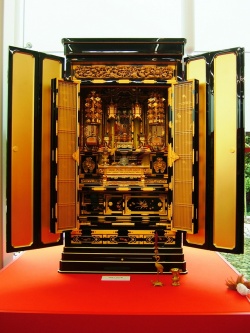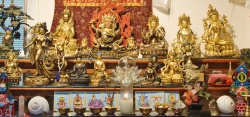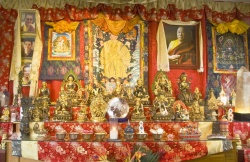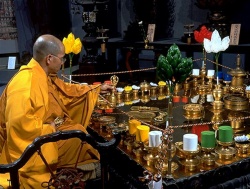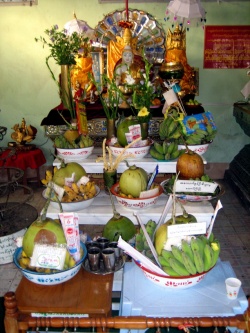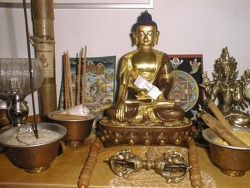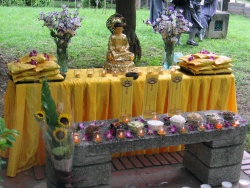Making a Buddhist Altar
From time to time, I get a lot of Google searches about making a Buddhist altar for oneself. People in Asia will often have a family home altar that gets passed down from generation to generation, but people in the West are either converts, or adults who are “rediscovering” their religion, so the situation is a bit different. Lately, the requests on my blog happen more and more often, so I wanted to
revisit this subject. I’ve written about our altar at home a few times, but I wanted to focus this time on how to make one of your own, and popular traditions in Japan associated with “using” the altar. This post has a strongly Japanese bias, so if you’re unsure, consult resources in your own Buddhist tradition too. Also, feel free to check out my YouTube video on the same subject.
First of course is the central image. As there are many Buddhas and Bodhisattvas in Buddhism, you may be inclined toward one or another.1 It depends on what seems to inspire you most, whether that be the historical Shakyamuni Buddha, Kannon Bodhisattva, Amitabha Buddha and so on. For the central image you have a few options:
Purchase one online. I have had pretty good luck with Rakuten International though translation issues can be a bit difficult. But if you’re willing to take a chance, you can get some of the best ones here because they’re genuine Japanese craftsmanship.
Another alternative here in the US is the BCA Bookstore. They import a lot of stuff from Japan, and although it’s a store for Jodo Shinshu Buddhism, they carry a pretty good selection. They’re also very friendly too.
Or just make your own!
If you’re on a real budget, than you can just make your own. I did this back in 2005 when I came back from Japan and first became very interested in Buddhism, but had no money then. I took a box lid and an image of Amitabha Buddha from the local Pure Land temple here in Seattle like so:
Obviously you can take an image you see on the Internet and print it out as your central image. That will work great. Or if you have a statue, put it inside. Or, if you have some skill with art, just draw your own. The Earthstore Bodhisattva Sutra, chapter 12, shows that if one draws an image of a devotional figure, it is like making a great offering too. This is also mentioned in the Lotus Sutra too.
Recently I did something similar as a “side altar” of my own that sits on a bookshelf:
The image in the middle is a tiny statue of the Medicine Buddha who I have been interested in since my visit to Kofukuji Temple in Nara, which I purchased on Rakuten. The image on the right is Kannon Bodhisattva. The cup on the left is an offering, which shows how small the statue is! The box and background came with the statue.
A few guidelines I’d recommend about making a Buddhist altar:
If you have room, make a special room for it. Most people can’t do this, so instead take an existing room and place the altar higher up if possible as a gesture of respect. Also, try to keep it out of rooms where you eat or sleep if possible. If you had a teacher you respected, you probably wouldn’t want them to see you make dinner or have sex in front of them. ;p
It’s good to keep it neat and tidy from time to time. Again, nothing’s required, but it’s a gesture of respect, as one would show a revered teacher.
When not in use, it’s often traditional to close it. Either close the lid, cover it, or something. But this isn’t required. It’s just how altars in Japan are often designed, presumably to keep the dust out, but also to mark off special time.
Offerings (mentioned below) are often given first thing in the day. For example, a cup of water or food might be offered before you eat your own breakfast as a gesture of respect and selflessness.
The point of all these rules of etiquette is to put oneself in the right frame of mind. People come to Buddhism seeking wisdom to help with their trouble in life, and just as one visits someone they revere and respect, using some simple etiquette one can approach the altar as one approaches their favorite teacher. This attitude isn’t just toward the altar, but is good for oneself too, and helps cultivate humility, compassion and so on.
Now what do you do with the altar?
People often do a few things: pray before it, chant, meditate, confess one’s transgressions and/or offer something as a gesture of respect, humility and gratitude. Frankly, I do pretty much all of them except meditation.2
First let’s talk about offerings. Traditionally offerings in Japan before an altar include one or more of the following:
A small bowl of rice.
A small cup of water.
Incense.
A candle.
Flowers and fruits.
Speaking of candles, the BCA bookstore sells LED candles for Buddhist altars. We own one and they’re actually really useful because the light really does look like a candle, shuts itself off in 10 minutes, and generates no heat, so it’s safe for use in a bookshelf (regular candles are too dangerous of course). We got our’s from my mother in law in Japan, but if you need a candle, consider getting one of these.
As for chanting and prayers, that’s a subject I covered here and here. If you’re affiliated with a temple now, you can definitely use the liturgy in your tradition before the altar, but if you’re alone, you can never fail with the Heart Sutra, or the nembutsu.
Often times a home-service might comprise of one or more of the following, time permitting:
Taking refuge in the Three Treasures:
I go to the Buddha for refuge; I go to the Dharma for refuge; I go to the Sangha for refuge.
Confessions of one’s transgressions, often something short and sincere like:
All of the misdeeds I have committed in the past are the result of my own Greed, Anger and Delusion. Before your eyes, I confess them all.
Taking the Five Precepts, even if you did it before. (i.e. renewing in order to uphold one’s conduct)
Chant a Buddhist liturgy or sutra, as described above.
Possibly chant an even smaller mantra or prayer to the central figure. This can be done 3, 7, 21, 108 or even more times During special times, I sometimes take up a certain Buddhist rosary I have and recite the nembutsu for the full rotation of the rosary (about 1,080 times) though I rarely have time or energy to do this. Most of the time I recite a mantra 3 or 7 times.
Dedicate the merit you’ve accumulated for this for the benefit of all sentient beings, even the ones you don’t like.
The key here is to find a level of practice you are comfortable with, and can sustain. If you try to overdo it, you’ll get burned out and give up. I know this from experience because of my heavy workload and very chaotic schedule with on-call shifts and such. Also, it’s not required to do this everyday. Again, find a sustainable routine, and adjust as needed.
For those raising little Buddhist families, the altar can be center of home life as well and one can lead home-services together, take turns, or even let children take part too. The point isn’t to “get it right”, but to cultivate a healthy balance of wisdom, humility, gratitude toward others and kindness, and the Buddhist is one very accessible to help make this happen. These are some of the many benefits of the devotional side of Buddhism.
Namu Shaka Nyorai
